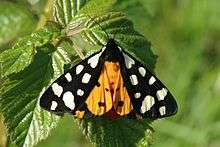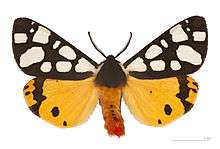Epicallia villica
Epicallia villica, the cream-spot tiger, is a moth of the family Erebidae. The species was first described by Carl Linnaeus in his 1758 10th edition of Systema Naturae. It is distributed from the Iberian Peninsula across western and southern Europe, Anatolia, western and northern Iran, western Siberia, southwestern Asia and North Africa.[1]
| Cream-spot tiger | |
|---|---|
 | |
| Scientific classification | |
| Kingdom: | Animalia |
| Phylum: | Arthropoda |
| Class: | Insecta |
| Order: | Lepidoptera |
| Superfamily: | Noctuoidea |
| Family: | Erebidae |
| Subfamily: | Arctiinae |
| Genus: | Epicallia |
| Species: | E. villica |
| Binomial name | |
| Epicallia villica | |
| Synonyms | |
Description
The wingspan of these moths reaches 45–60 mm.[2] They have black or greyish forewings with white and cream broad patches and spots. The bright red/orange hind wings have black spots. The thorax is black and the abdomen is reddish-orange. The highly-coloured parts are bright scarlet on a newly-emerged insect and tend to dull to orange with age. The caterpillars are black with light brown tufts of hairs, while the head and the legs are reddish. They can reach a length of about 12–12 mm.
Behaviour
The moths are nocturnal and attracted by light, but the females fly also during the day. By day these moths can be found resting on leaves. Moths of this species fly from March to July depending on the location.
The caterpillars feed on a variety of herbaceous plants, mainly dandelion (Taraxacum species), plantains (Plantago species), deadnettles (Lamium species), yarrow (Achillea species), blackberries (Rubus species), nettles (Urtica species), knapweeds (Centaurea species) and strawberries (Fragaria species).[3]
They overwinter, but they are relatively sensitive to frost. They can be seen in the spring after hibernation while feeding or seeking for suitable places to pupate. They pupate in May on the ground.
Habitat
This species inhabits woodland, areas with bushes and hedges and sunny open grassy areas.[2]
Subspecies
Philately
The cream-spot tiger appeared in 1992 on the German stamp of 100+50 pfennigs.
Gallery
- Imago
 Caterpillar
Caterpillar Museum specimen
Museum specimen Underside - museum specimen
Underside - museum specimen- On a German stamp
References
- Fauna Europaea
- Cream-Spot Tiger on UKMoths
- Savela, Markku. "Epicallia villica (Linnaeus, 1758)". Lepidoptera and Some Other Life Forms. Retrieved August 6, 2019.
- BioLib.cz
External links
| Wikimedia Commons has media related to Arctia villica. |
| Wikispecies has information related to Epicallia villica |